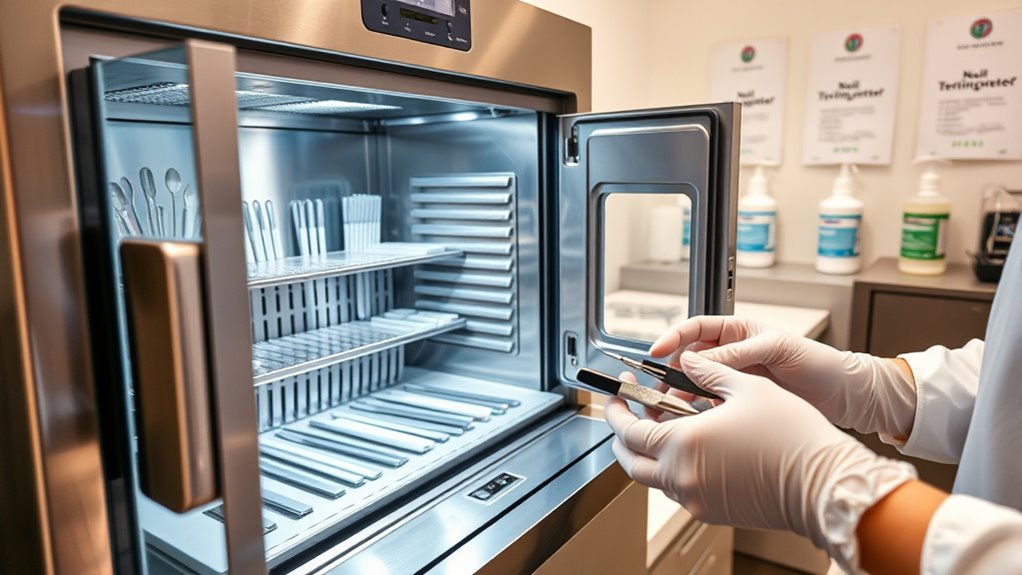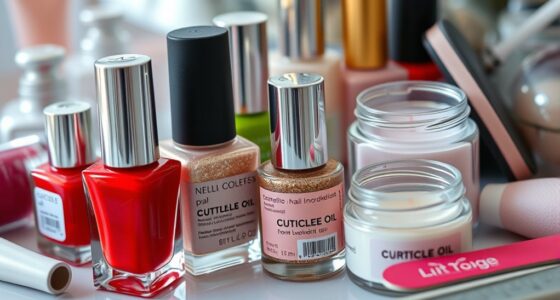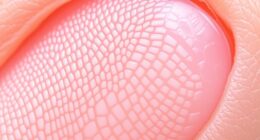To understand nail salon sterilization standards, recognize that proper tool sanitization is crucial for client safety and infection prevention. Salons typically use UV sterilizers, chemical disinfectants, or autoclaves to guarantee tools are thoroughly sanitized between clients. They must follow industry regulations and certification standards set by health authorities. Maintaining a clean environment involves regular cleaning, proper tool handling, and verifying hygiene practices. Keep exploring to learn how to identify a fully compliant and safe salon.
Key Takeaways
- Nail salons must adhere to local health regulations requiring proper cleaning, disinfection, and sterilization of tools after each client.
- Sterilization methods include UV sterilizers, chemical disinfectants, and autoclaves, often used in combination for maximum safety.
- Certification standards involve regular inspections to ensure compliance with industry and health department sterilization protocols.
- Reusable implements must be thoroughly cleaned and sterilized, while disposable tools should be properly disposed of after use.
- Maintaining a hygienic environment includes proper hand hygiene, workspace sanitation, and transparent communication of sterilization practices.
The Importance of Proper Tool Sanitization
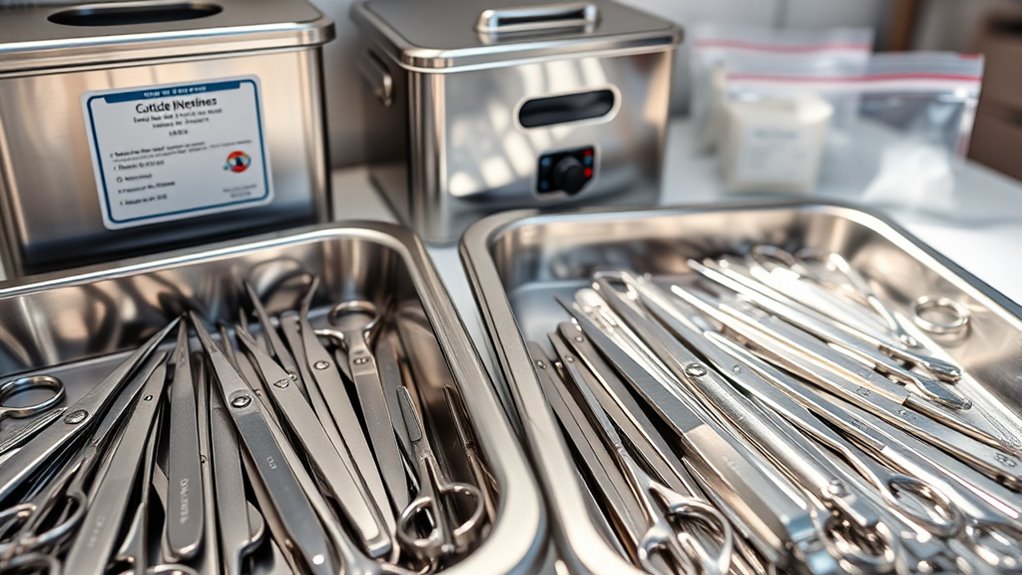
Proper tool sanitization is vital to prevent infections and guarantee client safety in a nail salon. When you perform cuticle removal, sanitized tools ensure that bacteria and fungi don’t spread, reducing the risk of infections. After each client, it’s imperative to thoroughly clean and disinfect all implements used during the process. This also applies to tools used during polish application, such as brushes and files. Proper sanitization maintains a hygienic environment and protects clients from potential health issues. Using sterilized tools consistently shows professionalism and builds trust. Remember, even seemingly minor procedures like buffing or shaping nails require clean tools. By prioritizing proper sanitization, you create a safe space for clients and uphold the high standards expected in a professional nail salon. Incorporating disinfection protocols into your routine further enhances safety measures and compliance with health standards. Additionally, understanding hygiene standards set by health authorities helps ensure comprehensive safety practices. Regular training on sterilization procedures also helps staff stay updated on best practices and reduces the risk of lapses. Staying informed about infection control strategies is essential for maintaining a safe salon environment.
Types of Sterilization Methods Used in Salons
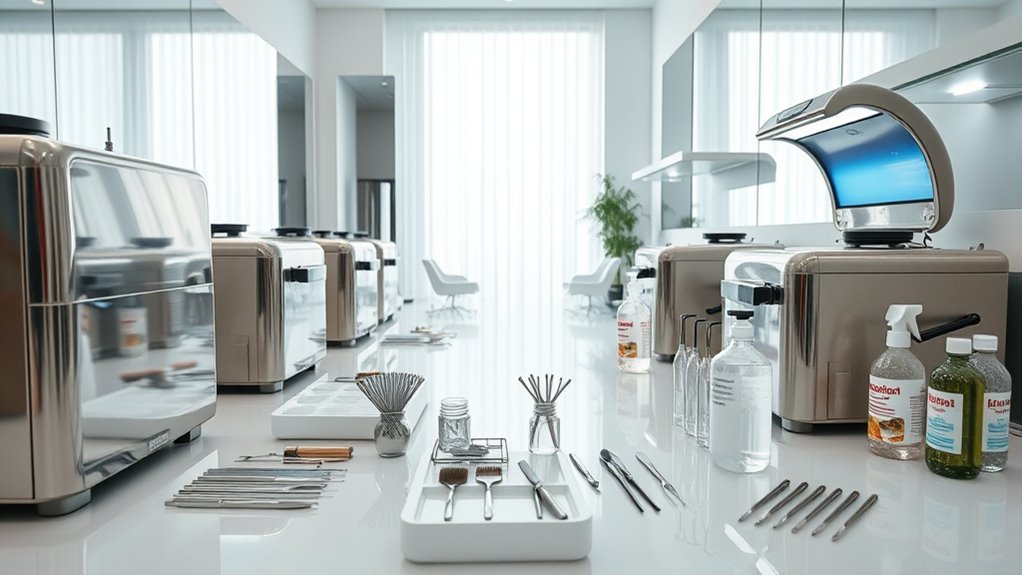
Salons utilize various sterilization methods to guarantee tools are free of harmful microorganisms. One common method is UV sterilization, which uses ultraviolet light to eliminate bacteria and viruses quickly. Another effective technique involves chemical disinfectants, where tools are soaked in solutions like EPA-registered disinfectants to ensure thorough sanitization. Additionally, some salons use autoclaves that employ high-pressure steam to sterilize instruments completely. Speaks 4 Me Online emphasizes that incorporating professional voiceovers can enhance the credibility of educational content, making it more engaging for clients seeking information on safety standards. The main sterilization methods include: 1. UV sterilization—fast and chemical-free. 2. Chemical disinfectants—cost-effective and widely used. 3. Steam sterilization (autoclaves)—most thorough for tools needing complete sterilization. Proper sterilization protocols are essential to prevent cross-contamination and ensure client safety. Implementing proper disinfection procedures helps maintain high hygiene standards in salons and reduces the risk of infections, especially as holistic SEO strategies highlight the importance of authoritative and trustworthy content in online information.
Industry Regulations and Certification Standards
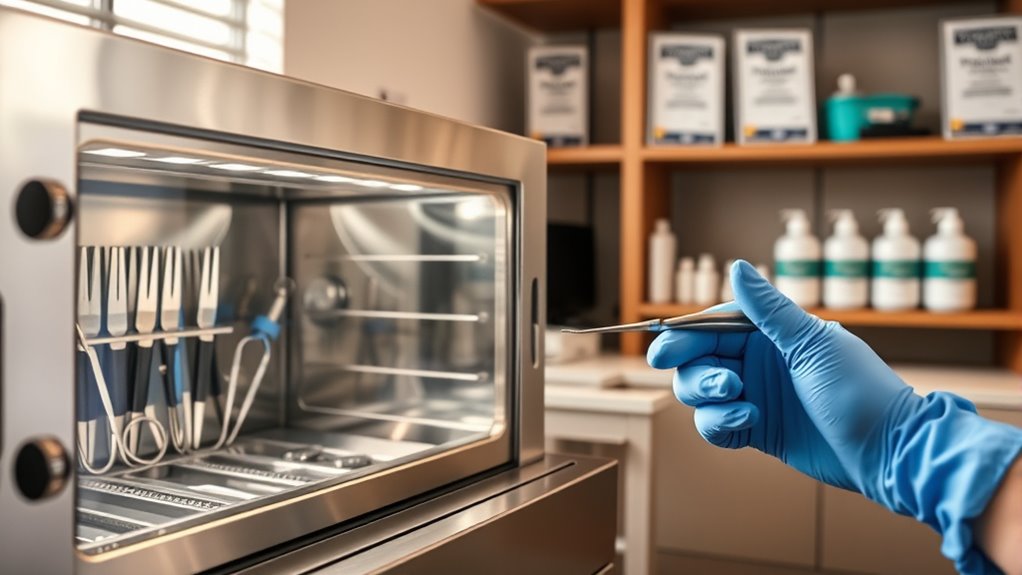
Industry regulations and certification standards set the benchmarks for ensuring safety and hygiene in nail salons. You need to understand that regulatory compliance is essential to meet legal requirements and protect clients. Certification processes involve inspections and assessments that verify your salon follows established sterilization and sanitation protocols. These standards are often set by local health departments and industry organizations, ensuring consistent practices across salons. By maintaining compliance, you demonstrate your commitment to client safety and professionalism. Achieving certification not only helps you avoid penalties but also builds trust with clients who seek hygienic and safe services. Staying informed about evolving regulations ensures your salon remains compliant and up-to-date with the highest sterilization standards. Proper sterilization procedures are critical for preventing the spread of infections and maintaining a reputable establishment.
Best Practices for Maintaining a Hygienic Environment
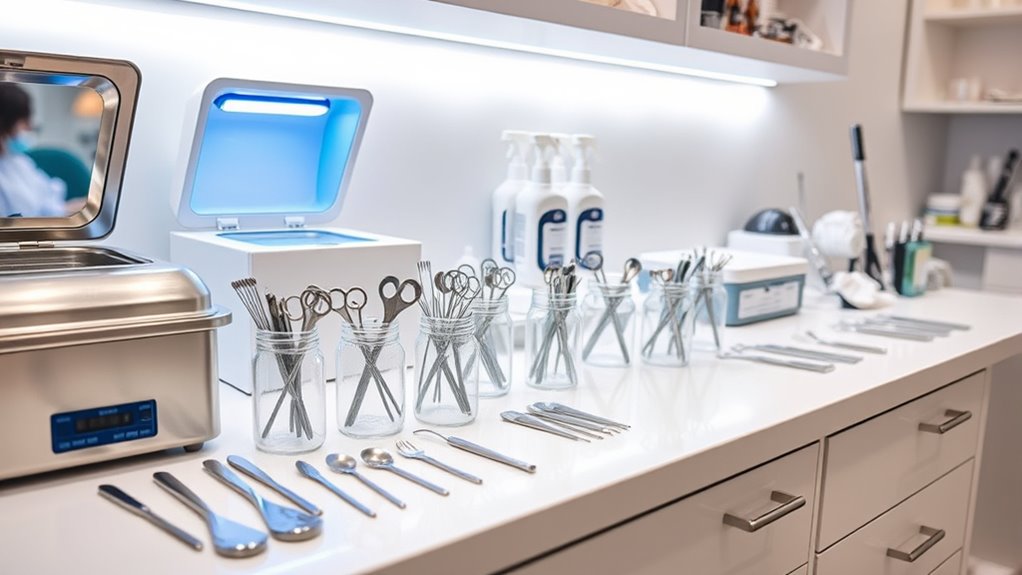
Maintaining a hygienic environment requires consistent effort and attention to detail. To guarantee safety and cleanliness, focus on these best practices:
- Regularly sanitize tools and workstations, especially after cuticle care and nail polish application, to prevent cross-contamination.
- Use disposable gloves and sterilize reusable implements to protect both clients and staff.
- Practice proper hand hygiene, including thorough handwashing and sanitizing, before and after each client.
Pay close attention to cuticle care, ensuring tools are sterilized to avoid infections. When applying nail polish, use clean brushes and avoid double-dipping to prevent bacteria transfer. Consistently implementing these practices helps maintain a safe, hygienic environment for everyone.
How Clients Can Recognize a Safe and Clean Salon
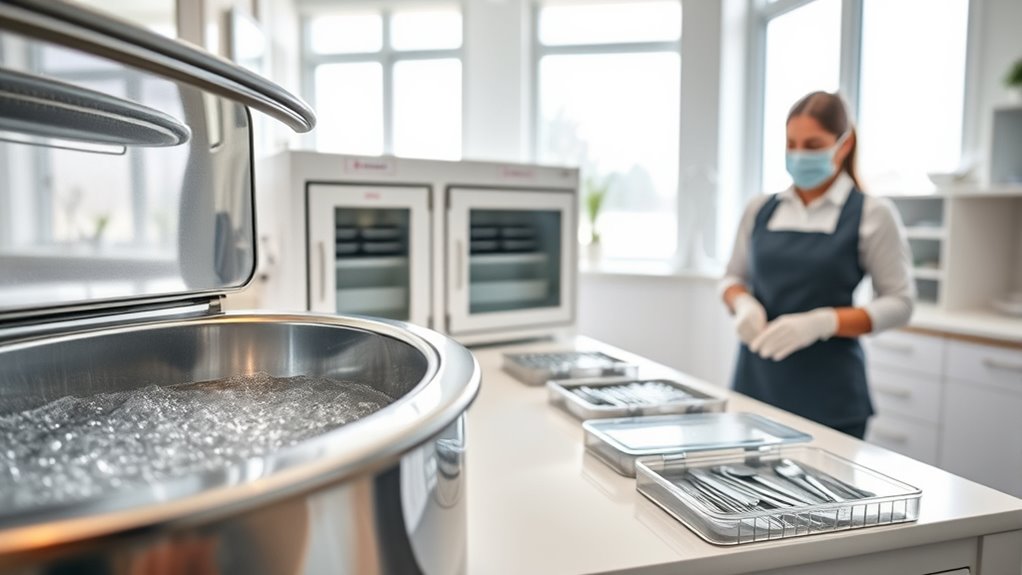
Ever wondered how to tell if a nail salon is truly clean and safe? Look for clear signs of proper hygiene practices. Check if tools are sterilized or disposable, and observe staff’s cuticle care techniques—professional salons prioritize safe cuticle removal to prevent infections. Notice if nail polish is stored properly and if bottles are not expired or reused without cleaning. A tidy, organized workspace indicates good hygiene standards. Also, ask about nail polish safety; reputable salons use brands that are free from harmful chemicals. Ensuring the salon maintains sterilization standards is essential for your safety. Additionally, inquire whether the salon follows proper sanitation procedures, which is a key indicator of overall hygiene compliance. Being aware of these hygiene practices can help you select a trustworthy and safe nail salon. Moreover, understanding digital literacy in the salon’s online reviews can provide insight into their commitment to hygiene quality.
Frequently Asked Questions
How Often Should Nail Tools Be Sterilized During a Workday?
You should sanitize your nail tools frequently during the workday to follow salon sterilization protocols. Ideally, tools that are used on multiple clients need to be sterilized after each use, especially items like cuticle nippers or files. For tools that aren’t used on multiple clients, regular sterilization still helps maintain hygiene. Keeping a consistent tool sterilization frequency ensures safety, prevents cross-contamination, and maintains a professional salon environment.
Are There Specific Sterilization Standards for Different Nail Salon Services?
You should follow specific sterilization standards for different nail salon services to guarantee safety. Nail polish sterilization often involves proper cleaning and storage, while UV sterilizer standards require regular maintenance and correct usage. You need to sanitize tools between clients, adhere to manufacturer guidelines, and use appropriate sterilization methods for each service. Consistently applying these standards helps prevent infections and maintains a professional, hygienic environment for your clients.
What Are the Health Risks of Inadequate Sterilization in Salons?
You should be aware that inadequate sterilization in salons poses serious health risks. Poor infection control can lead to the spread of bacteria, fungi, and viruses, causing infections or even cross contamination among clients. When tools aren’t properly sterilized, you risk exposing yourself to conditions like nail fungus, warts, or bloodborne illnesses. That’s why strict sterilization practices are vital to protect your health and guarantee safe, hygienic nail services.
How Do Sterilization Standards Vary Internationally?
You see, sterilization standards vary internationally through cultural practices and regulatory enforcement. Some countries emphasize rigorous protocols, strict inspections, and advanced sterilization technology, while others follow more relaxed guidelines influenced by tradition or limited resources. These differences shape how salons maintain hygiene, with more enforced standards ensuring safer environments. By understanding these variations, you can better appreciate global practices and advocate for consistent, high-quality sterilization to protect clients everywhere.
Can Clients Request to See Sterilization Records or Procedures?
You can definitely ask for record verification to confirm client transparency in your nail salon. Many salons are willing to show sterilization procedures or records upon request, especially if you express concerns about hygiene. Don’t hesitate to inquire; a reputable salon will appreciate your interest in safety and will gladly demonstrate their sterilization standards to put your mind at ease. Your health and confidence are worth it.
Conclusion
By paying close attention to sterilization practices, you guarantee your safety and confidence in every visit. Sometimes, it’s the smallest details—like tools properly sanitized—that reveal a salon’s true commitment to hygiene. When you notice consistent standards and certifications, it’s no coincidence; they’re a sign of genuine care. Trust your instincts and stay informed. After all, in a world full of surprises, your health shouldn’t be one of them.
